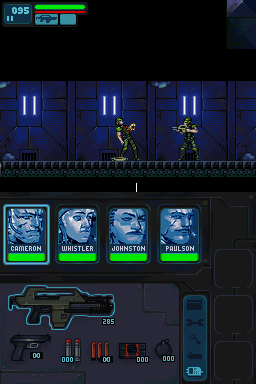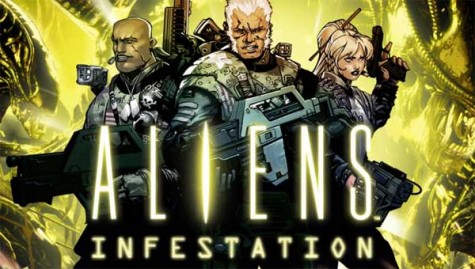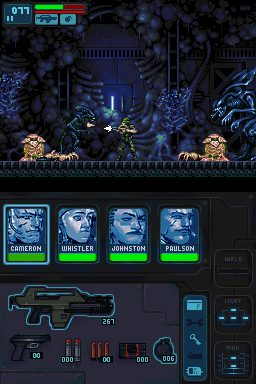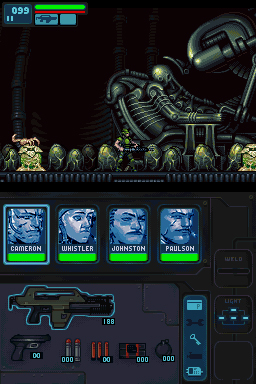When playing a licensed game that uses something as beloved and omnipresent as the Aliens franchise as its source material, the question that consistently intrudes on my fun is this: What makes this game worthy of the Aliens name? One of my biggest issues with a lazy licensed title is the blatant disregard and even contempt that some developers appear to have for the mythology they are trying to expand. So many games elect to cherry-pick precious few references or recognizable scenarios, lazily dropping the rest of the imagination on the player’s shoulders. We’ll add the monsters you like, and put you in a place you recognize, but the immersion part? That’s up to you.
Aliens: Infestation is definitely not one of those games.
To be honest, I am having a very hard time thinking of a single other Aliens title that engages with its source material so gleefully. You’d be hard-pressed to find a game from the series that has more classic one-liners, iconic set pieces and movie tie-ins as this one. What’s even more important is that these bits are not merely dropped in like a scant morsel being thrown to a famished dog, but rather are integrated into this specific story, respected as canon rather than a cheap throwaway name-drop meant to satisfy ravenous fans. When one marine is asked what he’s doing, the beleaguered soldier responds, “Mostly trying not to get eaten. Mostly.” Instead of using the power loader in one meaningless scuffle, the trademark battle machine pops into the game multiple times, serving as a valuable tool in defeating a Queen Alien and even unearthing a crucial item. Really, every nook and crannie of this game carries one or two bits of fan service, some of which I’m sure I didn’t even pick up on, simply because of the subtlety and care that Wayforward employed when building every square inch of this title.
Considering this deft execution and dedication to the Aliens franchise though, it’s a shame that the only place where the developers fail to hit the right notes is in the ambiance. It’s not for lack of trying, for sure. Throughout the entirety of the campaign, the game struggles with the shortcomings of the dated DS hardware to create a sense of suspense and tension. The music is suitably sweeping and engrossing, and Wayforward does their best to throw in lighting affects and jump scares, but all of these elements amount to little more than adorable little stabs at mimicking the more genuinely tense source material.
Where the struggling sense of atmosphere drops the ball, however, the sprite work picks it up and soars across the court. Every individual character, creature and weapon is animated beautifully, imbued with its own entirely unique personality. Xenomorphs are a genuinely intimidating foe to face, as they move with incredible speed and can evade your every attack with nimble precision. Their gorgeously animated movesets have them climbing on walls behind you, whipping you with their flailing tails and biting at you with their mini-mouths as you struggle to bring them down with your small arsenal of firearms. Every time I found myself stuck with two or more of these beasts in one room, I was genuinely stressed out. There’s always the option to run, but any xenomorphs you try to evade will follow you through doorways and even onto elevators, making them a authentically frightening and unwavering threat to fight.
The bosses, while daunting in appearance and difficulty, don’t share this same level of finesse. More often than not, facing your larger foes means firing your ammo at one target on their body for minutes at a time, dodging smaller enemies that attack you from below the hulking baddie. This wouldn’t be half as irritating if these bosses had health bars or at least changes in behavior to let you know just how close they are to death. This is especially apparent with the last boss, who I was banging up against repeatedly, never really sure if I was doing the right thing to defeat him. Considering how much care was put into the rest of the game’s combat, it’s surprising just how forgettable these bosses are.
Another feature that helps to prop up the uneven atmosphere is Infestation‘s utilization of the classic Aliens bioscanner. As most Sega fanatics know by now, this game is mapped out much like a Metroid game. You explore one large labyrinthine ship (or in the case of this game, a few), unearthing new items and abilities that allow you to progress to new areas that you couldn’t access before. Infestation sets itself apart by including the ever-beeping bioscanner, which alerts you to all lifeforms on the map using the trademark pulsing dots. What makes this so appealing is the fact that you never know just what these lifeforms are. They could be Xenomorphs, they could be eggs waiting to hatch, they could be idle characters roaming halls, or they could even be fellow marines waiting to be recruited as part of your team. Never really knowing just what lies beyond the next door adds an extra layer of stress and intrigue to the game, filling in the blanks where the atmosphere can occasionally fall a little limp.
This is not to call the map’s layout flawless, however. One of the most common complaints you get with this style of gameplay is just how much aimless searching can happen once the player runs out of places they can access. Wayforward’s decision to split the gameplay over a few separate maps helps to prevent the larger areas from becoming too complex or nonlinear, but the unfortunate decision to exclude the many hidden paths from the maps can make things a little frustrating later in the game, especially considering just how much is hidden deep within them in the final few moments. I had a couple bouts of confusion when I couldn’t remember where I had left certain characters or items, and ended up looking for them for a bit longer than I would have liked. The added flare system allows you to leave checkpoints, but since you are never able to pick them back up, it’s easy to overload your map and subsequently confuse yourself as to which flare to look for. It’s a niggling little flaw, one that I think is exacerbated by my abysmal sense of direction. Even so, I would have loved a navigation system that was just a tiny bit more intuitive.
Another clever twist on a standard convention is the game’s unique approach to gaining and losing lives. You start with four unique marines, each representing a specific archetype from the Aliens series or action movies in general. You play as each of these characters individually, trading off for a new personality every time one soldier dies in battle. That’s where things get interesting – once you lose one of these characters, they are dead for good. Unless your captain informs you otherwise (which I will explain in a minute), you will never see them again. Throughout the game, you will find some twenty more characters, each and every one of which with their own quirks, dialogue style and even their own nifty idle animation. This is easily Aliens: Infestation‘s single most successful and impressive feature, as it lends some real weight to the demise of each and every soldier. Losing one of your allies in battle actually matters, especially when you have no idea how long it will be until you stumble upon a new addition to your team. I found myself legitimately upset whenever a memorable personality that I had grown attached to disappeared forever. It makes the feeling of being hunted all the more palpable, and the threat of death less about reaching the end of the game and more about legitimate survival.
 My favorite twist in this system comes during the rare instance when your fallen teammate does not die. Instead, your captain informs you that your teammate’s vital signs are still kicking, and that you have a limited amount of time to find him in an alien nest hidden somewhere deep in the complex. I won’t tell you exactly what happens when your team member rejoins your crew, but suffice it to say that Alien fans will love it indubitably. It’s worth noting, however, that the placement of these fallen heroes is pretty random, and I often found that the character I was supposed to locate had been taken to an area that was impossible to reach, simply because I didn’t yet have the appropriate materials necessary to get to them. In the end, I only managed to save two teammates from the clutches of these nests, and even then the rescue came down to the wire.
My favorite twist in this system comes during the rare instance when your fallen teammate does not die. Instead, your captain informs you that your teammate’s vital signs are still kicking, and that you have a limited amount of time to find him in an alien nest hidden somewhere deep in the complex. I won’t tell you exactly what happens when your team member rejoins your crew, but suffice it to say that Alien fans will love it indubitably. It’s worth noting, however, that the placement of these fallen heroes is pretty random, and I often found that the character I was supposed to locate had been taken to an area that was impossible to reach, simply because I didn’t yet have the appropriate materials necessary to get to them. In the end, I only managed to save two teammates from the clutches of these nests, and even then the rescue came down to the wire.
The overall feeling I gather from Infestation is that of a delicious morsel that deserved to be more filling. There are a ton of really memorable little moments, like driving a speeding getaway car through waves of xenomorphs, facehuggers and chestbursters, or utilizing an airlock to flush an Alien Queen out into deep space. Occasionally clever ideas poke their way into the game, including new animal-based aliens and the aforementioned team-based life system. The problem is that all of these things are done and gone far too quickly. I burned through this game in less than five hours, and once I finished I just felt like I wanted a lot more. I thoroughly enjoyed what I experienced, and so many of the great things about this game simply didn’t have enough time to ferment and become something cohesive and whole. The game tasted delicious, but it just didn’t fill me up.
For fans of the license and Metroid: Fusion, Aliens: Infestation is an absolute must-play. Wayforward obviously poured a lot of genuine love into the title, and it really shows in the results. Less interested players may cringe at the woefully brief campaign and uninspired story, but at the discounted price, this love letter to Xenomorphs is undoubtedly worth your money.
B+





